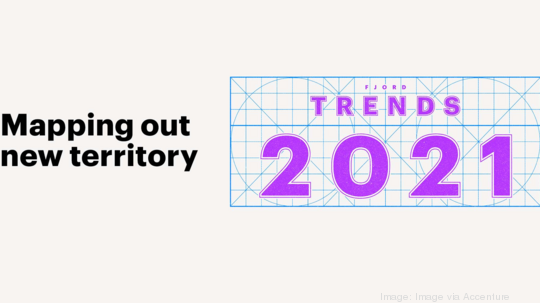
The past 12 months have felt like I’m competing in a reality TV show called “Change Warriors.” Anyone with me?
Think back to early 2020. How were you browsing for and purchasing your groceries, electronics, and healthcare services? I’m guessing it’s a 180-degree difference from the way you do today.
Now look at your home and office. Do you have college-age or grown children living with you now who weren’t just a year ago? Have you foregone a corporate commute for a short stroll from kitchen coffeemaker to home office desk?
If so, you are a fellow change warrior. We all are, due to a pandemic that is changing the way we work and live.
I work for Accenture, a company that helps other large organizations welcome change. Accenture Interactive publishes a global report annually on the trends that will most change the way we work, play, and live over the upcoming year. As I read the 2021 report, two trends have really resonated because they’re showing up throughout the U.S. southern region: Collective Displacement and Liquid Infrastructure. They point to a move companies will need to make in 2021: rethinking their physical assets and operating models.
Collective Displacement
Collective Displacement simply means that most of us have changed the way we work, play and live because of the pandemic.
Not only has COVID-19 changed individual habits, it’s changed geographies. The demographics of the U.S. southern states have shifted significantly, with most experiencing an influx of people moving into the region, many to be closer to family or to avoid a “pandemic winter” in frigid times. In addition, we’ve seen people move from more crowded urban centers to less populated rural or suburban communities.
We’re changing where we live and how we live faster than ever before—which means brands and businesses are having to keep up—and if they’re wise, anticipate customer and employee needs--at a speed they’ve never seen before.
Liquid Infrastructure
Retailers and manufacturers are having to completely rethink their strategies to address new consumer journeys, habits and expectations—making them more flexible or “liquid”. With almost 6.4 million people employed in the retail industry in the southern United States, and more than 5 million in manufacturing in the region, companies are reinventing the way they do things in real-time.
With fewer consumers in-store, retailers are having to rethink how to provide an engaging brand experience that keeps consumers coming back, even if it’s solely online. And consumer goods manufacturers are having to determine how to keep their products in steady supply—and that may mean selling direct to consumer is a viable option.
North-Carolina-based Lowe’s is a prime example of how retail companies have shifted the way they operate to better address the collective displacement of their consumers. The retailer has invested to make its supply chain more responsive to consumers who are shopping online more often, providing them more same-day and next-day service.
Atlanta’s Coca-Cola has changed its SKU lineup, reducing the number to focus on its most popular brands and converting existing manufacturers to different products. As Keith Woods, regional director of logistics, put it in an interview in late 2020: “Typically, the supply chain depends on historical data, but we didn’t have that when it came to defining consumer spending habits because we haven’t seen this [COVID-19] before.”
The shifts move beyond simply addressing new needs to a major question: How can liquid infrastructure move companies beyond safe choices, business-as-usual standard efficiencies and delivery, to a truly delightful experience for the consumer—even during a pandemic?
Follow the leaders: Reinvent.
We don’t yet know which changes will stick and which will flip post-pandemic. But in the meantime, companies who reinvent to better serve consumers and continue to stay a healthy brand are wise. It’s possible. The London Marathon, typically an in-person event, was able to pivot to 43,000 people participating virtually--a few hundred more than finished the 2019 marathon.
Let’s focus on the positive shifts you and your team can create out of this time of uncertainty:
Shopping is no longer about a place. It’s about multiple micro-moments consumers have across multiple devices during the day. How can you drive real-time, truly-personalized at the most opportune and appropriate moments?
How can you create immersive virtual experiences disrupt the hours of screen time that have become the new normal? Has your company investigated the possibilities in virtual and augmented reality, 5G, and 3-D content?
If home is the new store, how can your company provide the same immediate gratification and delight via a delivery experience versus a physical retail environment?
How has partnering changed? Houston-based Sysco, for example, collaboratively built a supply chain and billing system to serve grocery stores from the ground up, within a week.
How could technology make your supply chain more transparent, and thus more consistently and successfully responsive, to customer needs?
The consumer experience has irrevocably changed. I see companies finding new ways to delight by re-evaluating the new “hidden” parts of the customer experience. For example, is “waiting time” now a part of your customer experience? How can you turn it from a potential annoyance into a white space that delights your customer? How can you give your customers more transparency, more transparency, more reasons to engage?
These questions and more are what my teams are working on with clients, helping them reinvent to turn this year’s trends into growth drivers, instead of trying to maintain the status quo.
For more on Fjord’s 2021 full set of trends, check out this year’s report. All hail my fellow change warriors.
Steve Weinswig is a Managing Director and Design Lead – US South with Accenture. He’s passionate about helping business leaders tackle complex business challenges with a user-centric approach for digital transformation and brand growth.
